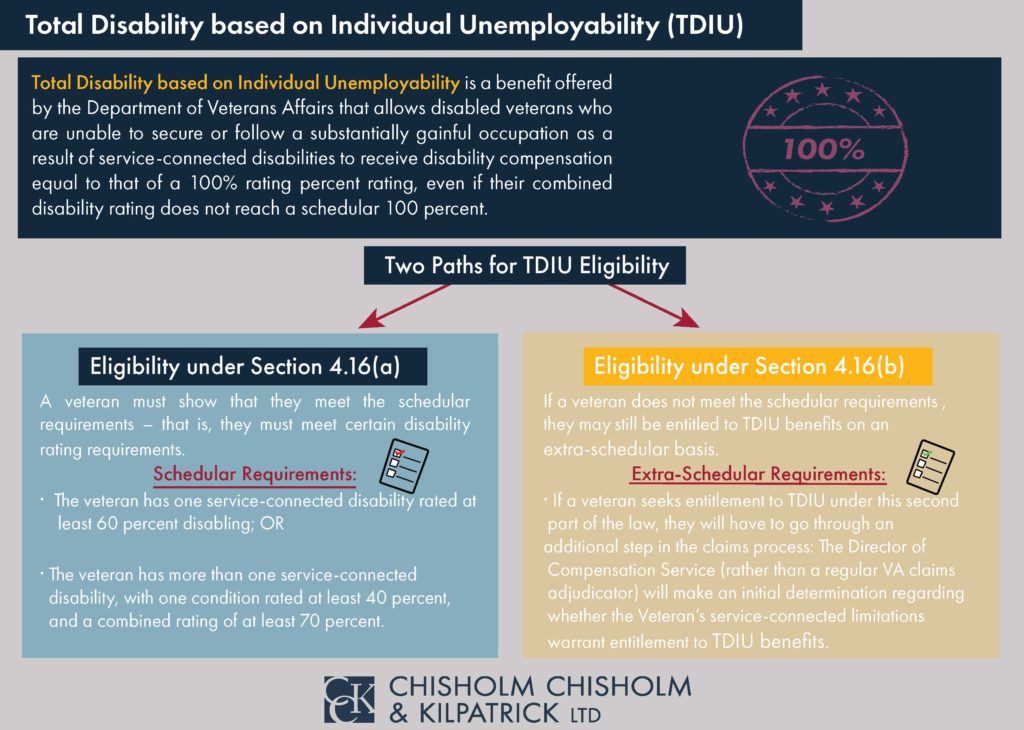VA Secondary Conditions to Back Pain

CCK Law: Our Vital Role in Veterans Law
Overview of Back Pain
Back pain is one of the most common orthopedic issues experienced by adults in the United States. It often leads to missed work, is a leading cause of disability worldwide, and can result in a variety of secondary conditions. Symptoms of back pain can vary, including:
- Shooting pain
- Aching pain
- Burning or stabbing sensations
- Cramps or spasms
Back pain may be exacerbated with bending, twisting, lifting, standing, or walking. Generally, back pain will gradually improve with home treatment and self-care within a few weeks. However, individuals with back pain should see a doctor if the pain:
- Persists past a few weeks
- Is severe and does not improve with rest
- Spreads down one or both legs, especially if the pain extends below the knee
- Causes weakness, numbness, or tingling in one or both legs
- Is accompanied by unexplained weight loss
Importantly, back pain often develops without an identifiable cause; however, common conditions linked to back pain include:
- Muscle or ligament strains – repeated heavy lifting or a sudden awkward movement can strain back muscles and spinal ligaments
- Bulging or ruptured disks – soft material inside a disk can bulge or rupture and press on a nerve, causing pain
- Arthritis – can lead to a narrowing of the space around the spinal cord (i.e., spinal stenosis)
- Osteoporosis – vertebrae can develop fractures causing pain
When diagnosing back pain, doctors will examine the individual’s back and assess their ability to sit, stand, walk, and lift their legs. The examiner may also ask the individual to rate their pain on a scale of zero to ten and talk about any impact it has on their level of functioning. Finally, the examiner may complete one or more tests, such as an X-ray, MRI, blood tests, bone scans, and nerve studies.
Common treatments for back pain include the following:
- Over-the-counter pain relievers (e.g., Advil, Motrin IB, Aleve)
- Muscle relaxants
- Topical pain relievers
- Narcotics
- Antidepressants
- Physical therapy
- Cortisone injections
- Implanted nerve stimulators
- Surgery
Generally, surgery is reserved for very severe cases of back pain.

Service Connection for Back Pain
Many veterans suffer from back pain following their military service. Chronic back pain can limit your ability to work, earn a living, and even perform basic activities, such as bathing and dressing. If you can establish service connection for your back condition, you might be eligible to receive VA disability benefits. Service connection is the acknowledgment by VA that a veteran’s current health condition (i.e., back pain) is related to their military service. Importantly, there are many types of service connection, including direct and secondary service connection.
Direct Service Connection for Back Pain
In order to establish direct service connection for conditions related to back pain, veterans must show evidence of the following:
- A current diagnosis of back pain or a back condition;
- An in-service event, injury, or illness; and
- A medical nexus (i.e., link) between the current, diagnosed back pain/condition and the in-service event, injury, or illness
However, it is important to note that there is an exception to the first element of service connection involving a current diagnosis. In April 2018, the Court of Appeals for the Federal Circuit held in Saunders v. Wilkie that VA must award disability benefits for pain due to military service. This means that if a veteran has pain related to their time in service, but does not have an underlying medical diagnosis, they can still receive VA disability benefits. This ruling is beneficial to those with back conditions, as many veterans experience back pain stemming from their time in service but do not have a diagnosis that identifies a cause of that pain. Nonetheless, veterans will typically need medical documentation from a healthcare professional indicating that their back pain is related to their service.
Secondary Service Connection for Back Pain
Veterans can also be service connected for back conditions that are not directly related to service. A secondary service-connected disability is a disability that resulted from a condition that is already service-connected. Here, veterans must provide medical evidence linking their back pain to their already service-connected condition.
The nexus between your primary condition and your secondary condition must be clearly established in order to be granted secondary service connection. For example, if a veteran has a service-connected knee condition that causes them to favor one side when walking, they might develop an altered gait. This uneven shift in weight may then contribute to complications and pain in their back. In this way, the veteran’s back pain is due to their service-connected knee condition, and therefore warrants secondary service connection.
Importantly, back pain can also cause secondary conditions for which service connection may be possible.
How to File for Secondary Service Connection
To file a claim for secondary service connection, veterans will generally follow the same process as filing any claim for service connection. This means filling out and submitting VA Form 21-526EZ. Veterans can file the form online using the eBenefits portal, in person at their local Regional Office, or with help from a VA-accredited representative.
Like regular claims for service connection, the veteran will need to submit certain evidence with their claim. For secondary service connection to be granted, the veteran must provide:
- A diagnosis for your secondary condition; and
- Medical evidence showing the link between your service-connected condition and secondary condition.
Specifically, veterans will need a nexus to link the primary, already service-connected condition to the secondary condition. Medical opinions from a medical provider can be very useful to demonstrate this link. Scientific studies which link the two conditions can also be used as evidence.
Additionally, lay evidence may also be helpful in regard to secondary service connection claims. Namely, veterans can submit lay statements outlining how their primary service-connected condition(s) caused or aggravated their secondary condition. Family members, such as a spouse, can also submit lay evidence which explains how the two conditions are linked. For example, if a veteran’s back pain caused their depression, a spouse may be able to explain this connection through a lay statement.

Secondary Conditions Caused by Back Pain
Oftentimes, back pain will cause other conditions, and these subsequent conditions may qualify for service connection on a secondary basis, as described above. Common examples of secondary conditions related to back pain include the following:
- Various types of radiculopathy
- Arthritis of the back
- Depression
Cervical Radiculopathy Secondary to Back Pain
Cervical radiculopathy is when a veteran has a pinched nerve in their neck. When there is pressure on a nerve in the neck, a veteran can experience radiculopathy in their shoulders, arms, hands, and fingers. The type of pain can vary from numbness, tingling, or burning, and can also range in severity from mild to severe.
Thoracic Radiculopathy Secondary to Back Pain
Thoracic radiculopathy occurs when a nerve in the upper back is pinched, and people may experience pain in their chest or torso area as a result. This is the least common type of radiculopathy.
Lumbar Radiculopathy Secondary to Back Pain
Lumbar radiculopathy is a common condition among veterans. This occurs when a nerve in the lower portion of the back is pinched, and it can cause numbness and tingling in the hips and legs. Incontinence can also occur as a result.
Arthritis of the Back Secondary to Back Pain
Degenerative arthritis of the back occurs when cartilage between joints erodes over time resulting in joint stiffness, limited mobility, and pain. This type of arthritis usually takes place in weight-bearing joints (e.g., back, hips, knees). Arthritis of the spine is a breakdown of the cartilage of the joints and discs in the neck and back.
Depression Secondary to Back Pain
Depression is a serious mental health condition that affects the way a person thinks, feels, and acts. Symptoms of depression tend to include the following: persistent feelings of sadness, worthlessness, and hopelessness; lack of motivation or interest in activities that are usually pleasurable; difficulty sleeping and concentrating; irritability; decreased energy; fatigue; and changes in appetite resulting in weight loss or weight gain. If a veteran suffers from debilitating back pain, it is possible that they will develop depression due to the chronic discomfort and limitations on activities of daily living.
Sleep Apnea Secondary to Back Pain
Sleep apnea is a condition where a patient’s breathing repeatedly stops and restarts throughout the night. This can lead to symptoms like loud snoring, restless sleep, and daytime sleepiness, as those with sleep apnea are often unable to sleep as deeply as others.
Sleep apnea and back pain can potentially contribute to one another. For instance, chronic back pain can make it harder for a veteran with sleep apnea to rest, exacerbating the symptoms of their apnea. Conversely, sleep apnea can cause increased pain sensitivity, leading to a veteran’s back pain feeling worse.
Obesity Secondary to Back Pain
Obesity is a condition characterized by the harmful accumulation of excess body fat, typically indicated by a body mass index (BMI) of 30 or greater. If a veteran has a back condition that makes movement difficult or painful, they may eventually develop obesity, which can then be service connected.

TDIU and Secondary Conditions to Back Pain
Back pain can be a particularly debilitating disability because of the way it can impact a person’s mobility. Back pain combined with another condition can then severely impact a person’s day-to-day life. Specifically, many veterans with back pain and conditions secondary to back pain may be prevented from obtaining or maintaining substantial employment. As such, veterans with these disabilities may be eligible to qualify for TDIU. TDIU, or total disability based on individual unemployability, is a monthly VA disability benefit available for veterans who are unemployed or make less than substantially gainful employment.
Generally, there are two pathways to become eligible for TDIU:
- 38 CFR § 4.16a (“Schedular”) – For this form of TDIU, the veteran must have:
- One condition rated at minimum 60 percent; OR
- Two conditions that can be combined to reach 70 percent, where one condition is at a minimum of 40 percent
- 38 CFR § 4.16b (“Extraschedular”) – This form of TDIU is for veterans who may not be able to achieve the ratings necessary for schedular TDIU but are still unable to obtain substantially gainful employment on account of their conditions.
- In this instance, the veteran must prove that their condition hinders their ability to obtain substantially gainful employment and therefore should not be rated based on the standard disability rating criteria.
Importantly, secondary service-connected disabilities do factor into a veteran’s combined rating. This essentially means that a secondary service-connected disability can help a veteran achieve the criteria needed to qualify for TDIU on a schedular basis. Once the veteran has been awarded TDIU, they will be compensated at the 100 percent rating level, regardless of their combined rating percentage.
TDIU can be a confusing topic, which is why veterans often benefit from seeking the aid of a VA-accredited attorney to help them navigate the complexities of TDIU and ensure their claim has the best possible chance of success. If you have chronic back pain or a related condition and want to pursue TDIU for your VA claim, consider reaching out to CCK Law for a free evaluation of your case.
Was Your VA Claim Denied?
The accredited attorneys and advocates at Chisholm Chisholm & Kilpatrick LTD have decades of experience successfully representing disabled veterans and their families before the Department of Veterans Affairs, the Court of Appeals for Veterans Claims, and the Federal Circuit. We may be able to help if your claim was denied. Contact us today online or at 800-544-9144.
About the Author
Share this Post


